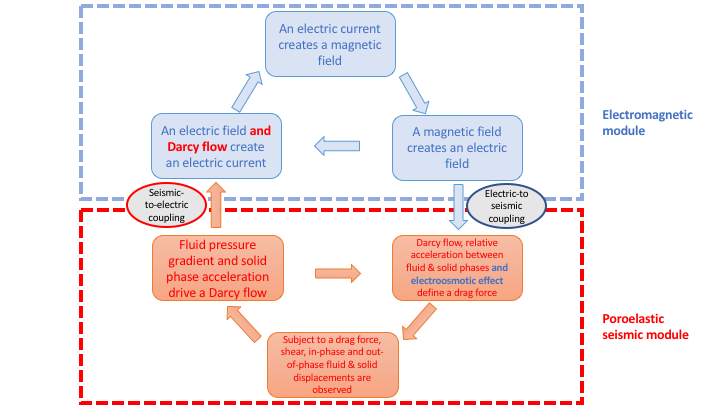Christina Morency (17-LW-029)
Executive Summary
We are developing a tool that utilizes the physical coupling between seismic and electromagnetic phenomena in porous media to detect and visualize sub-surface fluid flow. This project will provide new applications of seismic-electromagnetic effects to practical subsurface imaging problems for energy services and environmental site characterization.
Project Description
Various energy technologies, including carbon-dioxide sequestration, involve injecting large amounts of fluids in the subsurface. Currently, our knowledge of subsurface fluid transportation is relatively weak below the depth of 1 km, and current methods for mapping fluid-saturated fracture networks down to reservoir-relevant depth have limitations. Traditional seismic-imaging techniques fail to resolve fluid-phase properties, while pure electromagnetic approaches provide no constraints on rock structure and have shallow ground penetration. We are combining seismic-electromagnetic effects, which take place in porous media and correspond to conversion of seismic signals to electric signals, with traditional seismic-imaging and electromagnetic approaches. Coupled seismic and electromagnetic signals can be used to recover electrical conductivity and permeability data (as well as density and seismic wave speeds) and identify subsurface layers and thin fractures. Our approach differs from current joint decoupled seismic and electromagnetic inversions, which integrate multiple data triggered and recorded separately. (In seismic inversion, seismic-reflection data is transformed into a quantitative rock-property description of a geological formation.) By physically decoupling seismic and electromagnetic problems, these methods risk introducing errors from strong nonlinear couplings and missing potentially crucial phenomena such as seismic-electromagnetic effects. By taking full advantage of the physical coupling between seismic and electromagnetic phenomena in porous media, we will improve our understanding of seismic-electromagnetic effects as well as their potential to better characterize the subsurface.
Seismic-electromagnetic effects are related to pore-fluid movements with respect to the solid grains. By analyzing coupled porous elastic seismic and electromagnetic signals we expect to capture pore-scale behavior and access both structural and fluid properties. Using this new method, we expect to solve the forward and inverse problems to model seismic-electromagnetic effects in porous media. For the forward problem (the fully coupled seismic and electromagnetic system), we will use a spectral-element finite-element method to solve coupled wave equations (specifically, porous elastic-wave equations, which describe the behavior of fluid-saturated porous media, and Maxwell’s electromagnetic wave equations). For the inverse problem, we will use an adjoint-tomography method for obtaining imaging and characterization of the subsurface. The adjoint approach has been implemented for a porous elastic seismic wave system and validated with a synthetic study of carbon dioxide sequestration monitoring. Adding electromagnetic measurements will add crucial constraints on the movement of the fluid phase. This approach will improve our understanding of seismic-electromagnetic effects and demonstrate their potential for constraining the properties of solids and fluids in the subsurface. Our approach offers a new method to map fluid-saturated fracture network, with applications to practical subsurface imaging problems.
Mission Relevance
This project supports DOE's science and energy objective to deliver scientific discoveries and tools that transform our understanding of nature and strengthen the connection between advances in science and technology innovation. It also supports the Laboratory's Earth and atmospheric science core competency and the energy and climate security research and development challenge by providing a new technique for monitoring fluid transport and fracture-network detection relevant to geophysics, energy exploration and extraction, and carbon dioxide sequestration.
FY17 Accomplishments and Results
In FY17 we (1) developed and implemented the electromagnetic wave equation based on a spectral-element method; (2) identified the equations to be implemented; (3) drew an equivalence between the elastic and electromagnetic fields such that the code used for elastic/poroelastic wave equations is converted to handle the electromagnetic wave equations; and (4) coupled poroelastic and electromagnetic equations.
Publications and Presentations
Morency, C., 2017. "Seismoelectric Effects Based on Spectral-Element Method for Subsurface Fluid Characterization." American Geophysical Union Fall Meeting, New Orleans, LA, 11-15 December 2017. LLNL-ABS-736429.






